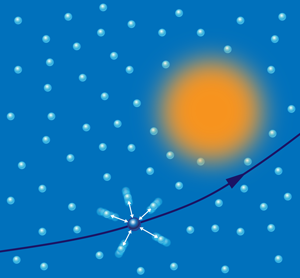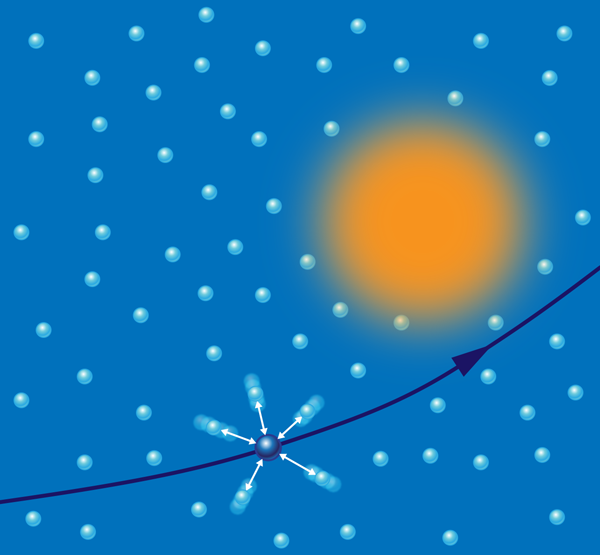Quantum Jostling Proves Diverting for Electrons in a Metal
Electrical resistance in metals like copper and silver mainly comes from the scattering of electrons by vibrations in the crystal lattice (phonons). These vibrations die away at low temperatures, which explains why metals become less resistive when you cool them. But a small “residual resistivity” persists at low temperatures because electrons also scatter from impurities, such as a vacancy or an atom of a different species, which are always present in any real metal. So far, the residual resistivity was thought to only depend on the interaction between each electron and the impurities, but a new theory from Vladimir Nazarov and Yia-Chung Chang at the Academia Sinica, Taiwan, and Giovanni Vignale at the University of Missouri in Columbia shows that dynamical interactions between electrons—a many-body effect—also make a distinct contribution in the presence of impurities [1]. Their theory provides the first quantitative description, from first principles, of the resistivity of simple metals at low temperatures. As an example, they show that many-electron effects can explain the measured value of the residual resistivity of aluminum.
One of the oldest theories in condensed-matter physics is that of the conduction of an electrical current through a metal. In Paul Drude’s 1900 classical perspective [2], electrons in a metal are constantly moving in all directions, rather like molecules in a gas, but since their net momentum is zero, so is the current. Applying a voltage between the ends of the conductor creates an electric field that causes the electrons to veer slightly towards the positive end, producing a net current. From time to time, collisions once again randomize the electrons’ directions of motion. The frequency of such collisions determines the metal’s resistance.
A seismic shift in the Drude picture occurred in 1933. Physicists realized that electrons had to be treated as quantum particles, subject to the Pauli exclusion principle that prevents more than one electron from occupying each quantum state. Arnold Sommerfeld [3] showed that, as a result, only a small number of electrons—those with the highest energies—are actually available to participate in conduction. This Drude-Sommerfeld theory is the basic theory of conduction that physics students learn today. It has major successes, including the Wiedemann-Franz law that relates electrical conductivity to thermal conductivity and temperature.
To obtain quantitative predictions from the theory, it is crucial to describe the collisions that randomize the electrons’ directions, since the conductivity is inversely proportional to their rate. In addition to scattering from vibrations (phonons), electrons also scatter from one another because of Coulomb repulsion. But unlike electron-phonon scattering, electron-electron scattering does not contribute to the conductivity of a uniform metal because it conserves momentum and so does not affect the total current. Instead, the main contribution to the resistivity at low temperatures arises from the scattering of electrons from the impurity atoms dotted throughout any real metal sample. This has been confirmed by experiments that show the low-temperature conductivity depends on the density of impurities.
Drude-Sommerfeld theory provides a qualitative account of the effect of impurities on resistivity. But the theory makes an assumption that is not fully justified: each electron is considered as moving independently through the crystal lattice. This point of view has the merit of simplicity, which is why it is the one taught in undergraduate physics. But in reality, the electrons are a strongly interacting “soup”: each electron is in close proximity to many other electrons, which repel it strongly, so that the proper description is more like a dense electron liquid rather than the “electron gas” often used in teaching. As the electron moves through this liquid it is constantly being squeezed and jostled by the neighboring electrons because of quantum fluctuations (see Fig. 1).
The realization that these quantum fluctuations contribute to residual resistivity is the key to Nazarov et al.’s new work, who point out that impurity scattering affects the many-electron wave function and vice versa. The general framework for the treatment of such effects is the Kubo formula of many-body theory [4], which sets down an exact relationship between the conductivity and a response function that describes the correlation between an electron’s velocity at a point and the earlier velocity of another electron some distance away. In practice, however, the Kubo formula is too difficult to calculate exactly. A more feasible approach—and the one that Nazarov et al. adopt—is density-functional theory (DFT) [5], in which electrons are assumed to be independent but moving in an effective potential that contains the effects of electron-electron interactions. Information carried in the many-electron wave function is, in principle, obtained from a much simpler quantity: the electron density or the electronic current density. In the latter case, called current-density-functional theory (CDFT), the potential is a vector quantity.
DFT has been tremendously successful at describing the properties of atoms, molecules, nanostructures, and solids [6], and, in principle, is an exact theory. In practice, however, the DFT “exchange-correlation” (xc) potential—the potential that contains the effect of electron exchange—has to be approximated. And approximations that work when describing the ground state may not be adequate for describing electrical conduction, which is an excited-state property that must be treated by the time-dependent versions of density-functional theory and current-density-functional theory (TDDFT [7] and TDCDFT [8], respectively). In these theories, nonlocality (in space) and/or memory effects (nonlocality in time) can be crucial. This turns out to be the case in the work of Nazarov et al.
The authors start by expressing the Kubo formula within the framework of TDCDFT. They account for the effect of electron-electron interactions on the conductivity in two ways. One is to adjust the static potential created by each impurity atom, including electrostatic screening. The second effect, which they term “dynamical corrections,” arises from TDCDFT’s exchange-correlation “kernel,” which relates changes in the xc vector potential to changes in the local current density.
Using this approach, Nazarov et al. calculate xc contributions to the resistivity arising from the shear modulus and shear viscosity of the electron fluid. As in a classical fluid, these quantities describe the shear forces arising from shear displacements and velocity gradients of the fluid, respectively. Theorists have so far mainly focused on the shear viscosity because this is the quantity in liquids that, like resistivity, is associated with dissipation. However, in the present case, the important thing is the interplay between the effect of the impurity potentials and the many-electron response function. Nazarov et al. show that, in fact, the shear modulus, and not the shear viscosity, plays the dominant role.
The authors use their theory to numerically calculate the total low-temperature resistivity of aluminum for different species of impurity atom, obtaining impressive quantitative agreement with experiments in each case. The authors show that dynamical electron-electron corrections can contribute up to – of the total resistivity. These corrections are strongest for transition-metal impurities because these atoms have tightly bound electron clouds that modulate the electron liquid’s density and hence its shear modulus.
The new approach from Nazarov et al. has so far only been applied to aluminum. But it should be possible to incorporate it into electronic-structure codes for studying other materials. In the future we may see quantitatively accurate predictions for the low-temperature resistivity of a range of inhomogeneous metals and nanostructures.
References
- V. U. Nazarov, G. Vignale, and Y.-C. Chang, “Dynamical many-body corrections to the residual resistivity of metals,” Phys. Rev. B 89, 241108 (2014)
- P. Drude, “Zur Elektronentheorie der Metalle,” Ann. Phys. 306, 566 (1900)
- A. Sommerfeld and H. Bethe, Elektronentheorie der Metalle (Springer Verlag, Heidelberg, 1933)[Amazon][WorldCat]
- Ryogo Kubo, “Statistical-Mechanical Theory of Irreversible Processes. I. General Theory and Simple Applications to Magnetic and Conduction Problems,” J. Phys. Soc. Jpn 12, 570 (1957)
- W. Kohn and L.J. Sham, “Self-Consistent Equations Including Exchange and Correlation Effects,” Phys. Rev. 140, A1133 (1965)
- A Primer in Density Functional Theory, edited by C. Fiolhais, F. Nogueira, and M. Marques, Lecture Notes in Physics (Springer-Verlag, New York, 2003)[Amazon][WorldCat]
- C. A. Ullrich, Time-Dependent Density-Functional Theory (Oxford University Press, Oxford, 2011)[Amazon][WorldCat]
- S. K. Ghosh and A. K. Dhara, Phys. Rev. A 38, 1149 (1988); G. Vignale and W. Kohn, Phys. Rev. Lett. 77, 2037 (1996)





